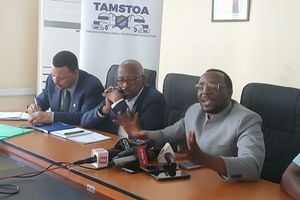The untold story of trafficked girls abused in mining towns

What you need to know:
- Eliza’s story reflects the tales of many young girls from the mineral-rich regions of Kahama and Geita, where the girls, mostly from Burundi, Rwanda, and the DR Congo, find themselves trapped in a cycle of suffering and despair.
Kahama/Geita. "I have been using my body to benefit my boss. Sometimes, I serve two to three men in a night, but all the money goes to the boss,” Eliza*, a 16-year-old victim of human trafficking in Kahama District, tells The Citizen.
Eliza’s story reflects the tales of many young girls from the mineral-rich regions of Kahama and Geita, where the girls, mostly from Burundi, Rwanda, and the DR Congo, find themselves trapped in a cycle of suffering and despair.
Lured by promises of securing decent jobs, the girls have often found themselves trapped in unspeakable horrors, including being forced to sell their bodies to fulfil the desires of the transient mining communities.
A two-month investigation by The Citizen has revealed that a dreadful network that preys on unsuspecting victims looking for a better life is responsible for orchestrating the inhumane practice.
The innocent young girls are taken from their home villages on the promise of securing better jobs. Most have ended up terribly and suffering at the hands of the cabal.
Eliza shares her heart-wrenching experience, recounting how false promises brought her and 18 other girls to Kahama in 2022.
The initial excitement of finding a better job crumbled, she says, as they came to discover the harsh reality of small, dismal houses and a worrying welcome by seemingly jubilant women at the small town of Mwime Gold Mine in Kahama.
Eliza recalls the chilling moment when a man singled them out based on their age: “Look, these are the most beautiful ones; they are still young.”
Local residents who spoke to The Citizen blame the unchecked exploitation of the young girls on a lack of oversight and isolation in the small mines, which provide a fertile ground for such acts to flourish.
Upon arrival, the teenager reveals that she and others were divided among “bosses” who owned small huts used as guest houses. Forbidden from leaving, Eliza recounts the pain of serving multiple men in one night while receiving none of the promised salary. “My body ended up benefiting my ‘boss’, she says in pain.
According to Eliza, clients pay between Sh2,000 and Sh10,000, depending on the time and ‘beauty’ of the girl. “Underage girls and new ones are more expensive compared to the older ones.”
Despite occasional authorities’ searches, some girls, like Eliza, remain hidden and trapped, unable to escape such mistreatment.
One of the security officers in the area says: “There are no school-going children here; most of the girls you see come from neighbouring countries. But Tanzanian children are in schools; we cannot allow them to enter the mines.”
“We do send them away, but these young girls are still coming. You should simply know that there is a very big network of people involved in bringing and using them for dirty business,” he added.
The situation on the ground calls for the urgent need to stop the practices, given the profound human rights violations taking place.
Kahama District Immigration Officer, Mr Salum Rashid, acknowledged the ongoing efforts of his unit to track down and arrest the culprits.
He gave statistics on the operation to halt the business, saying not less than 50 children are repatriated every month on average.
He says later, both the victim and the locals who hosted and exploited them were brought to justice.
“We have many cases concerning these illegal activities. We have been taking perpetrators to court, and we send the victims back to their countries,” he reveals.
“Every month we repatriate not less than 50 children,” he stresses, adding that some who are old enough are taken to court, calling for more collaboration to end the menace.
Mr Rashid says one of the major challenges immigration officials face is the fact that some victims often falsely claim to come from the local communities along the borders, but upon checks, they realise that most of them come from Bunjumbura, Rwanda, or the DR Congo.
Under its mining, child protection, and employment laws, the government prohibits children under the age of 18 from engaging in hazardous work, including mining.
The Citizen’s investigation has also revealed that several young boys have also fallen victim to the abuses.
“The gravity of the situation extends beyond girls,” says an official in Mbogwe District Council, Geita Region (name withheld). “They too find themselves in exploitative situations, working in various capacities in towns and mines,” he says.
Authorities occasionally inspect mines for child labour to see how they can rescue teenagers trapped in hazardous labour.
“Those boys, mostly from neighbouring countries, mix with natives and conduct petty businesses for their employers or work in restaurants. Others are still working in mines despite the government restrictions,” he affirms.
“We are worried that these people can continue to live and clandestinely get citizenship. That’s why we keep on cracking them down, even though there are some difficulties.”
A network of complicity
Inquiries have also shown that poverty, limited education, and a lack of employment opportunities create a breeding ground for traffickers to prey on vulnerable families.
Recruiters, transporters, middlemen, and those who turn a blind eye all play a role in this nefarious web, operating within a network that spans borders.
A woman, one of the ‘bosses,’ reveals the intricate process through which teenagers are brought into this dark world.
“There are agents who bring these girls here; even boys are brought, but for them, they end up in the cities, with some becoming criminals and later citizens. There’s a long list of people involved.
“I often use my girls to sell food at my restaurant, but others want to earn extra money, so at night they turn sex workers, but during the day they go back to work as usual.
“Most of these girls are not Tanzanians; that’s why they work hard here compared to Tanzanian girls,” she explains.
According to her, there are other people in the area who hire the girls directly for the sex trade.
“That’s why it’s clear; even some of my girls are engaged in those activities; it’s very normal here, although there are immigration officers who always monitor these areas.”
Voices of resilience and hope
Amidst the darkness, non-governmental organisations (NGOs) and grassroots activists are working to curb human trafficking, provide support to victims, offer rehabilitation, and raise awareness within communities about the dangers of human trafficking.
Leaders of these organisations usually collaborate with government authorities to address the problem.
The executive director of a Shinyanga-based NGO, Ms Lydia Agostino, highlights the challenges they face due to financial constraints but remains optimistic about a brighter future.
“The efforts we are making in collaboration with authorities bring new hope to these girls trapped in this exploitative cycle,” she affirms.
She says there is a time when social welfare officers collect the victims, but due to financial constraints, they release them, only to rejoin the illegal businesses.
The NGOs have been working on multiple fronts: rescuing victims, offering them rehabilitation, and raising awareness within communities about the dangers of trafficking.
Mr Rashid affirms that they were aware of the uphill task of hunting down the people behind the business and promised to keep tracking them to prevent violence against children’s rights.
Supported by Bill & Melinda Gates Foundation





